The Quake that Killed Thousands
Looking Back at Nepal Earthquake of 2015: A Sad Memory
April 25, 2015.The morning felt usual. People drank tea at the local tea shops, chatted away time, laughed at a joke in a jovial mood. Early summer and yet the air felt heavily laden with the heat of the noon-day sun. It all passed just as usual.
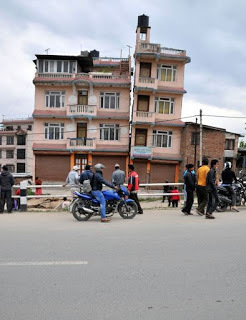 Having suffered a psychological trauma I had no job, and funnily no pocket on my shirt. No money, and no pocket to carry it; that would sound fine. And that made me feel a little uncomfortable. Working through an on-going book, I needed a place to hold and carry at least my pen, and having talked with an artisan who worked at a local business that produced ready-made wear I was planning for an upgrade: a patch-pocket on the left bosom of my half shirt.
Having suffered a psychological trauma I had no job, and funnily no pocket on my shirt. No money, and no pocket to carry it; that would sound fine. And that made me feel a little uncomfortable. Working through an on-going book, I needed a place to hold and carry at least my pen, and having talked with an artisan who worked at a local business that produced ready-made wear I was planning for an upgrade: a patch-pocket on the left bosom of my half shirt.He measured the shirt, we agreed upon a basic hexagon design, he rummaged through a small heap of discarded cut-pieces and somehow managed to produce a small piece of fabric that had an agreeable colour for a patch-work: it did not exactly match the colour of the shirt but was doable with. He immediately set to work in front of his electric sewing machine.
Leaning over with my hands on the table, I was fascinated by the high-speed movement of the needle, and a thin trail of thread that it left behind, on the fabric. PPP—RRRRRRR! The machine went on. PPP—RRRRR——PPP—RRRRR!!
“Why do you shake the table man?” he asked me after a little while as he was turning and folding the fabric piece, under the boot of the high-speed electric sewing machine.I was confused a little bit at his remark at first as I was not shaking his table, and drew back, standing straight. Damn! The full horror of it came into me just about then: the whole ground beneath me was shaking violently.
“It’s a quake,” I muttered. The ground felt unsteady, the wall moved, the machine rattled side to side. An eerie sound echoed into the head: the frightening sound of death looming close by.
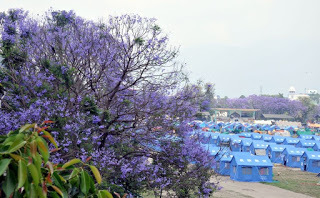 “What?!!” He asked, surprised.
“What?!!” He asked, surprised.“A qu—ake…” I shouted and tried to run out. Had it been at other times, I might have laughed at myself as I felt rather wobbly passing the narrow corridor, my hands feeling for a support on either side of me. The door was wide open and I could make out the bright light of day just a few meters off, but I alternated pressing on the right wall and the left a number of times just to cross the distance of a mere 5 or 6 meters: nothing was stable.
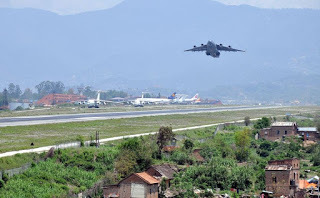 It felt like I was drunk-dancing even when outside of that trap-hole. I am not afraid of sudden death but the horror of being left crippled with a few bones broken upsets me all the time. The instinct then was to run, but once outside I could see the electric poles swaying in the air as if it was made of a flexible rubber. The bunch of wires clattered as they rubbed against each other. Commuters on motorbikes just dropped their vehicles and ran wobbly, horrified at the uncontrollable instability of the machine on wheels, and at the same time, not being sure of their own legs. The air was filled with echoes of helpless trepidation, and people around felt like dolls filled just with fear and nothing else, with horror written all over their empty faces. The ground was still shaking as if you were standing on a small dinghy and huge waves crashed against it.
It felt like I was drunk-dancing even when outside of that trap-hole. I am not afraid of sudden death but the horror of being left crippled with a few bones broken upsets me all the time. The instinct then was to run, but once outside I could see the electric poles swaying in the air as if it was made of a flexible rubber. The bunch of wires clattered as they rubbed against each other. Commuters on motorbikes just dropped their vehicles and ran wobbly, horrified at the uncontrollable instability of the machine on wheels, and at the same time, not being sure of their own legs. The air was filled with echoes of helpless trepidation, and people around felt like dolls filled just with fear and nothing else, with horror written all over their empty faces. The ground was still shaking as if you were standing on a small dinghy and huge waves crashed against it. 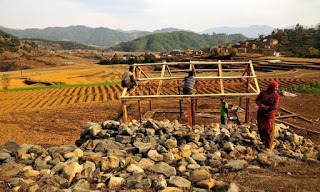 Knees half bent for balance as the ground continued shaking, I looked at the horror of things from the middle of the street: the poles swayed as if their sole purpose were to dance in a frightening manner while the cables they carried sang clattering songs. People’s voices filled the air: voices loud and low, far and near. Voices that appeared unusual to the ears as if all of that formed some background noise of some distant world. Adding to that, crows cawed from the air, and as I tried to look up at the roofs of the houses, I saw the buildings sway, the pillars supporting the water tanks high up on their rooftops sway dangerously. It was chaos all around.How long did it take for all of this to happen? About 45 seconds!
Knees half bent for balance as the ground continued shaking, I looked at the horror of things from the middle of the street: the poles swayed as if their sole purpose were to dance in a frightening manner while the cables they carried sang clattering songs. People’s voices filled the air: voices loud and low, far and near. Voices that appeared unusual to the ears as if all of that formed some background noise of some distant world. Adding to that, crows cawed from the air, and as I tried to look up at the roofs of the houses, I saw the buildings sway, the pillars supporting the water tanks high up on their rooftops sway dangerously. It was chaos all around.How long did it take for all of this to happen? About 45 seconds!Counting from one to forty-five with each ticking second of the clock; that is how long it all took. And after that, everyone was shaken. They brought out blankets and mattresses from their homes into the open grounds. “The quake went,” people say in our tongue. “It will return,” they shouted and whispered. Nobody was willing to stay indoors.
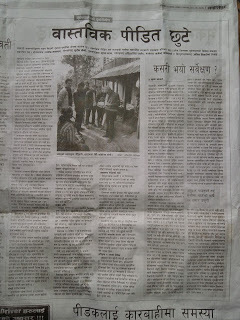 Old people got shaken to their cores. Young ones were not allowed by their parents to go inside their homes. One bunch in the ground followed another and another until the whole village settlement came out with one form of mattress or another. Water was fetched from the shops nearby as were light snacks, cigarettes and packs of playing cards. Then someone complained to someone else that it felt too hot. Someone rushed on a motorbike and fetched a tarpaulin from the nearby store. A tent was born in the open.
Old people got shaken to their cores. Young ones were not allowed by their parents to go inside their homes. One bunch in the ground followed another and another until the whole village settlement came out with one form of mattress or another. Water was fetched from the shops nearby as were light snacks, cigarettes and packs of playing cards. Then someone complained to someone else that it felt too hot. Someone rushed on a motorbike and fetched a tarpaulin from the nearby store. A tent was born in the open.Someone else drove some old stakes and sticks into the ground and spread plastic sheets over making another makeshift tent for the older relatives.
Local shops ran out of snacks and water and juices in no time. Radio broadcasts talked about possible after-shakes; old people already had specific language referrals for “going” and “returning back” of the quake.
A jerk followed. Then another movement that shook the ground. Terrified people brought out their stoves and cooking pots and pans into their tents, locking their homes from outside. At some point, it even felt like people were now going back in time: abandoning their concrete houses for the sake of plastic and tarpaulin tents. It felt so overwhelming. The next day, television news and video footages came out: buildings collapsed, monuments crumbled, people got buried, hospitals became overcrowded with the injured. Chaos and destruction overshadowed everything !
A sense of helplessness followed everyone, everywhere. Then the international community responded. Aid started to pour in. The only international airport in the country became overloaded and burst its seams, diverting passenger jets elsewhere as the cargo-carrying giants landed and took off. Some of the largest planes ever made came in and went away; some of the strangest planes such as the Harrier Jets came over for rescue operations.
The Israelis came with their mobile hospitals, the Chinese and the Japanese came with tents and sophisticated rescue equipment, the French came with the medicines. The Indians came with media to proclaim false aid: “we did this and that, and reached here and there, before anyone else” they claimed. Yes, they did reach places, but what help did they offer to the victims rather than carry their military and media personnel up to the Chinese border??
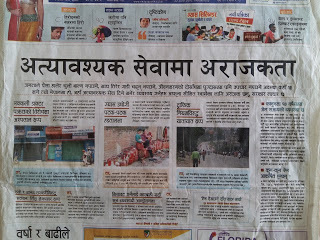 The people who were outside did not went in; those who were in came out one by one as the aftershocks continued. Open grounds became covered with tents of all odd shapes sizes and colours. Stores ran out of them in no time.
The people who were outside did not went in; those who were in came out one by one as the aftershocks continued. Open grounds became covered with tents of all odd shapes sizes and colours. Stores ran out of them in no time.Then another big shake followed on 12th May. The houses that were shaken by the first big quake collapsed down to the ground. The first one had been measured to be 7-points-8, they said; the second one was measured to be 7-points-3. A total of nearly ten thousand lost their lives. Millions became homeless.
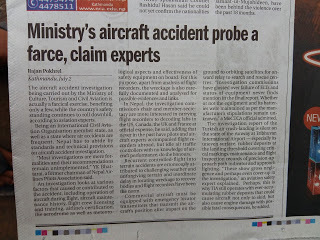 The government changed the rules where law and order does not exist. Donors could directly offer aid to the victims before, but now they could not; they had to go through government channels. Those who were receiving at least some now missed out on even food, water and medicine. Everything from tents and blankets to rice from Bangladesh, one of the poorest nations in the region, got channelized into government coffers. Were they actually distributed? I doubt it, given the fact that tents and blankets marked by the donors were later seen in the markets for sale. Rice disappeared somewhere, tents were seen inside the complexes of politicians and party leaders. All the money that were sent into the rehabilitation fund set up by the government got either unaccounted for, or has not been heard of since. As I write these lines, victims have already suffered two monsoon seasons and are still living under the tents and makeshift shelters. Roads are being swept away by monsoon floods, landslides are claiming lives of hundreds, and floods are sweeping away people as if they were mere ants! Many of these have been left out as the ones taking their surveys have not included them as victims in the database. Why? The officials were asking for bribes, and the poor were not able to pay them! What a shame!!
The government changed the rules where law and order does not exist. Donors could directly offer aid to the victims before, but now they could not; they had to go through government channels. Those who were receiving at least some now missed out on even food, water and medicine. Everything from tents and blankets to rice from Bangladesh, one of the poorest nations in the region, got channelized into government coffers. Were they actually distributed? I doubt it, given the fact that tents and blankets marked by the donors were later seen in the markets for sale. Rice disappeared somewhere, tents were seen inside the complexes of politicians and party leaders. All the money that were sent into the rehabilitation fund set up by the government got either unaccounted for, or has not been heard of since. As I write these lines, victims have already suffered two monsoon seasons and are still living under the tents and makeshift shelters. Roads are being swept away by monsoon floods, landslides are claiming lives of hundreds, and floods are sweeping away people as if they were mere ants! Many of these have been left out as the ones taking their surveys have not included them as victims in the database. Why? The officials were asking for bribes, and the poor were not able to pay them! What a shame!! Those who never had homes in the first place got registered as victims and received donations; those who have had everything taken away with their homes remained left out. Houses and buildings that never should have been authorized for construction in the first place also suffered the consequences; but who was there to blame? Nobody took any responsibility.
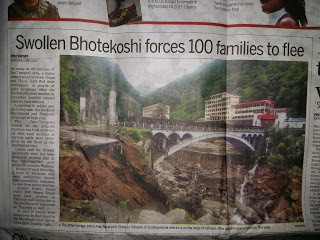 It is sad that the donor community had given freely for the use of people during the time of crisis, but the corrupt government and officials have freely used them as their own and neglected the plight of millions. It is also sad that Nepal Food Corporation, the sole state agency responsible for food management and distributions is trying to sell rice donated by Bangladesh as it is not efficient in distributing it to the victims and poor people. Or is it that officials high up found it difficult to consume all the rice by themselves in collaboration with their relatives and hence are trying to convert it into money that everyone can consume?
It is sad that the donor community had given freely for the use of people during the time of crisis, but the corrupt government and officials have freely used them as their own and neglected the plight of millions. It is also sad that Nepal Food Corporation, the sole state agency responsible for food management and distributions is trying to sell rice donated by Bangladesh as it is not efficient in distributing it to the victims and poor people. Or is it that officials high up found it difficult to consume all the rice by themselves in collaboration with their relatives and hence are trying to convert it into money that everyone can consume? Almost two rainy seasons have passed now, and a year and a half has elapsed since the big quake; and more than a thousand small and big quakes have come and gone. Monsoon is heavy; the poor sleep under the tarpaulins and tents rattled by relentless rains while the rich and powerful are blind to the drops that perforate the roofs of fate. Life still continues but the rules keep changing: the reach of the rich knows no bounds, and there is no confusion as to what the rich with reach have been doing all along!
[Researched and written on the request of Tessy Beaulin; Radio 100.7, Luxembourg. Photographs first appeared in National Geographic: Your Shot page at http://yourshot.nationalgeographic.com/profile/378231 Newspaper clips are for reference purposes only. Texts and photographs by Subarna Prasad Acharya. © July 2016. All rights reserved.]
Published on July 31, 2016 01:38
No comments have been added yet.



